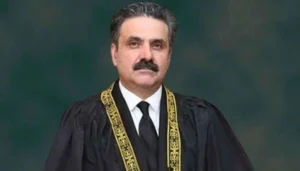Justice Yahya Afridi: New Chief Justice of Pakistan

Breaking Development
Pakistan’s parliamentary committee has nominated a new Chief Justice of Pakistan through an unprecedented selection process. The committee bypassed traditional succession protocols to select the third-most senior justice for the position.
The Selection Process
Formation of the Committee
A specially formed twelve-member parliamentary committee now oversees judicial appointments. The committee includes eight members from the ruling coalition and four opposition seats.
Procedural Changes
The new selection method represents a significant departure from Pakistan’s traditional seniority-based system. Previous appointments automatically elevated the most senior Supreme Court justice to Chief Justice.
Committee Composition
The committee’s structure raises questions about representation and balance. Four members represent the majority party, while three belong to the coalition partner.
Political Implications
Opposition’s Stance

Pakistan Tehreek-e-Insaf, the main opposition party, refused to participate in the selection process. They cited serious concerns about the committee’s formation and legitimacy.
Legitimacy Questions
The opposition challenges the entire parliamentary structure. They point to alleged irregularities in recent elections and question the government’s mandate.
Political Maneuvering

Multiple attempts to secure opposition participation failed. Political intermediaries made extensive efforts to bring opposition members into the process.
Constitutional Crisis
Legal Framework
The new selection process creates tension with existing constitutional provisions. Traditional interpretations favored automatic succession based on seniority.
Precedent Setting
This appointment could fundamentally alter Pakistan’s judicial appointment system. Future Chief Justice selections might follow this new committee-based model.
Constitutional Challenges
Legal experts anticipate potential challenges to the appointment process. The Supreme Court may need to address questions about the committee’s constitutional validity.
The Nomination Impact
Immediate Effects
The nominated justice must now decide between two options. They can accept a three-year term as Chief Justice or maintain their current position.
Career Implications
Accepting the Chief Justice position would reduce the nominee’s total Supreme Court tenure. Their current appointment extends for five years.
Institutional Changes
The appointment signals a shift in judicial-parliamentary relations. It increases legislative oversight of judicial appointments significantly.
Current Leadership’s Response
Outgoing Chief’s Actions
The departing Chief Justice issued a strongly worded dissenting opinion. The opinion challenges recent Supreme Court judgements and their implementation.
Implementation Disputes
Questions arise about enforcing Supreme Court decisions pending appeals. The outgoing Chief Justice suggests certain judgments lack immediate enforceability.
Judicial Division
The dissenting opinion highlights growing divisions within the Supreme Court. Senior justices disagree on fundamental constitutional interpretations.
Professional Ethics Concerns
Conflict of Interest
Several committee members maintain active legal practices. Their dual roles as lawmakers and practicing attorneys raise ethical questions.
Future Appearances
Concerns exist about committee members appearing before their selected Chief Justice. This situation could create perception problems in future court proceedings.
Professional Standards
The legal community debates appropriate boundaries between judicial selection and legal practice. Many call for stricter separation between these roles.
Political Establishment’s Role

Government Strategy
The ruling coalition carefully orchestrated the selection process. They sought to balance political interests while maintaining procedural legitimacy.
Opposition Engagement
Multiple attempts to secure opposition participation occurred. Government intermediaries made extensive outreach efforts throughout the process.
Power Dynamics
The appointment reflects shifting power balances between institutions. It demonstrates increased parliamentary influence over judicial appointments.
Future Scenarios
Acceptance Pathway
If the nominated justice accepts, significant changes to court leadership will begin immediately. This would establish new precedents for future appointments.
Alternative Outcomes
Rejection of the position could trigger a new selection process. The committee might then consider other candidates from the senior judiciary.
Legal Challenges
Constitutional petitions might challenge the entire selection process. Such challenges could create uncertainty in judicial leadership.
Institutional Implications
Judicial Independence
The new selection method raises questions about judicial autonomy. Traditional safeguards relied heavily on the seniority principle.
Parliamentary Oversight
This appointment strengthens legislative influence over the judiciary. It creates new mechanisms for parliamentary input in judicial leadership.
Systems Change
The process represents a fundamental shift in institutional relationships. It alters long-standing traditions in Pakistan’s judicial system.
Public Impact
Trust in Institutions
The controversial selection process affects public confidence in judicial institutions. Many question the transparency and fairness of the new system.
Legal Stability
Uncertainty about the appointment’s validity could affect legal proceedings. Cases might face delays pending resolution of constitutional questions.
Democratic Process
The situation highlights tensions between democratic oversight and judicial independence. It raises fundamental questions about institutional balance.
Forward Outlook
Short-term Effects
Immediate challenges to the appointment seem likely. Legal and constitutional questions will require resolution.
Long-term Changes
This precedent could permanently alter Pakistan’s judicial appointment system. Future selections might follow this new committee-based model.
Systemic Impact
The changes affect relationships between government branches. They create new dynamics in Pakistan’s constitutional framework.
Resolution Pathways
Legal Options
Constitutional courts may need to address the appointment’s validity. Clear legal precedents must establish future appointment procedures.
Political Solutions
Broader political consensus might emerge through negotiation. All parties recognize the need for stable judicial leadership.
Institutional Reforms
Long-term solutions require careful balance between oversight and independence. Future reforms must address current systemic weaknesses.
Conclusion
The appointment marks a crucial moment in Pakistan’s judicial history. It creates new precedents while raising significant constitutional questions.
This transition period will likely shape future institutional relationships. Its resolution will influence Pakistan’s constitutional development for years to come.
The situation demands careful consideration of democratic principles and judicial independence. Finding the right balance remains crucial for institutional stability.
